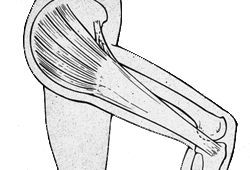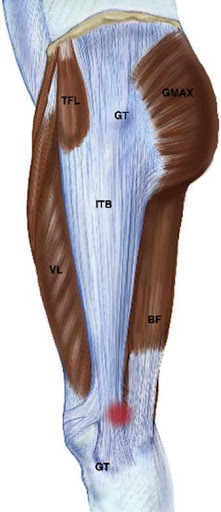Resumo
Definição
História e exame físico
Principais fatores diagnósticos
- presença de fatores de risco
- dor aguda ou ardência acima da interlinha articular lateral
- teste de Noble positivo
- teste de Ober positivo
- teste de Thomas modificado positivo
Outros fatores diagnósticos
- força do músculo abdutor do quadril reduzida
- geno varo (perna arqueada), retropé e antepé varo e pé cavo (arco alto)
- epicôndilo femoral lateral proeminente
- edemaciamento, edema local ou crepitações
Fatores de risco
- atleta
- alta quilometragem semanal
- treinamento intervalado
- fraqueza muscular de extensores do joelho, flexores do joelho e abdutores do quadril
- falta de experiência em corrida
- uso de tênis de corrida desgastado
- corrida em declive ou corrida em uma superfície curvada ou escorregadia
- sexo feminino
- contratura da banda iliotibial preexistente
- discrepâncias de comprimento de membros inferiores
- largura do passo e taxa de deformação
- joelho varo em corredores do sexo masculino
- fraqueza muscular nos músculos rotadores externos do quadril em corredores do sexo masculino
- excessiva rotação interna do quadril em corredores do sexo masculino
Investigações diagnósticas
Primeiras investigações a serem solicitadas
- diagnóstico clínico
Investigações a serem consideradas
- radiografia do joelho
- ultrassonografia do joelho
- ressonância nuclear magnética (RNM) de joelho
Algoritmo de tratamento
dor e inflamação
remissão da dor e da inflamação
refratária ao tratamento conservador
Colaboradores
Autores
Bob Baker, PT, PhD, MBA, OCS

Rehabilitation Services Manager
NorthBay Healthcare
Fairfield
CA
Declarações
BB is an author of articles cited in this topic.
Jenson C. Mak, PhD, FRACP, FAFRM, FACP, MBBS

Rehabilitation Fellow
University of Sydney
Sydney
Australia
Declarações
JCM declares that he has no competing interests.
Michael Fredericson, MD, FACSM

Professor of Orthopaedic Surgery
Stanford Medical Center
Stanford University
Stanford
CA
Declarações
MF is an author of several articles cited in this topic.
Revisores
Robert Werner, MD
Professor
Chief of Physical Medicine and Rehabilitation
Ann Arbor VA Medical Center
Ann Arbor
MI
Declarações
RW has been reimbursed by the University of Michigan for attending several conferences and has been paid an honorarium for speaking at the American Association of Neuromuscular and Electrodiagnostic Medicine national meeting. RW has been paid by the National Institute for Occupational Safety and Health, the American Dental Association, and SmartHealth as a consultant and has received grant funding from the UAW/GM Health and Safety Board (over US$1 million).
Créditos aos pareceristas
Os tópicos do BMJ Best Practice são constantemente atualizados, seguindo os desenvolvimentos das evidências e das diretrizes. Os pareceristas aqui listados revisaram o conteúdo pelo menos uma vez durante a história do tópico.
Declarações
As afiliações e declarações dos pareceristas referem--se ao momento da revisão.
Referências
Principais artigos
Fredericson M, Weir A. Practical management of iliotibial band friction syndrome in runners. Clin J Sport Med. 2006 May;16(3):261-8. Resumo
Artigos de referência
Uma lista completa das fontes referenciadas neste tópico está disponível para os usuários com acesso total ao BMJ Best Practice.

Diagnósticos diferenciais
- Tendinopatia do bíceps femoral
- Doença articular degenerativa
- Entorse do ligamento colateral lateral (LCL)
Mais Diagnósticos diferenciaisDiretrizes
- Practical management of iliotibial band friction syndrome in runners
Mais DiretrizesVideos
Exame físico do joelho
Mais vídeosConectar-se ou assinar para acessar todo o BMJ Best Practice
O uso deste conteúdo está sujeito ao nosso aviso legal
